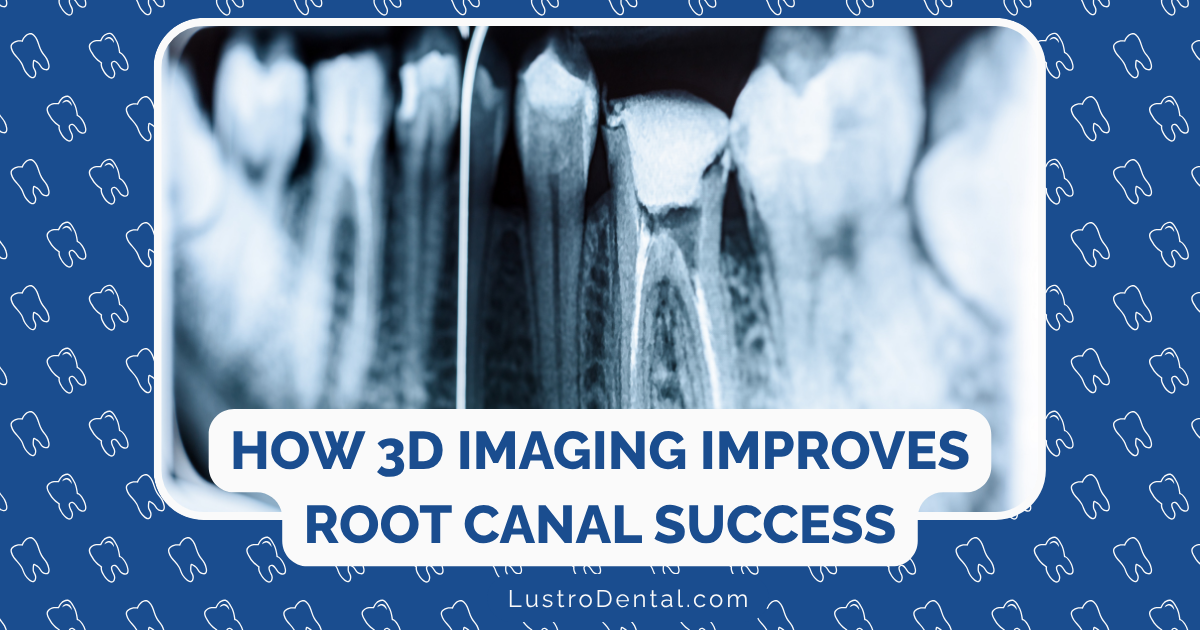3D Imaging in Endodontics: Finding Hidden Canals for Better Outcomes

Have you ever wondered why some root canal treatments fail despite the best efforts of skilled endodontists? The answer often lies hidden within the complex anatomy of your tooth—literally. Missing a canal during treatment is one of the most common reasons for root canal failure, and it’s a challenge that has plagued the field of endodontics for decades.
But here’s the good news: advanced 3D imaging technology is changing the game, allowing endodontists to see what was previously invisible and dramatically improving treatment outcomes.
The Hidden Challenge in Root Canal Therapy
Root canal anatomy is surprisingly complex. While textbooks might show neat, symmetrical canals, the reality is far messier. Teeth can have extra canals, unusual branches, or complex configurations that are nearly impossible to detect with traditional 2D X-rays.
According to a study published in the Journal of Endodontics, up to 40% of treatment failures occur because a canal was missed during the initial procedure. These hidden canals become reservoirs for bacteria, eventually leading to persistent infection and pain.
Dr. Samuel Kratchman, Clinical Professor of Endodontics at the University of Pennsylvania, explains: “The anatomy we can’t see is often what determines our success. Traditional radiography simply doesn’t show us the complete picture.”
Enter 3D Imaging: A Revolution in Visualization
Three-dimensional imaging, particularly Cone Beam Computed Tomography (CBCT), has revolutionized how endodontists visualize tooth anatomy. Unlike traditional X-rays that compress three-dimensional structures into flat images, CBCT scanners rotate around the patient’s head, capturing hundreds of detailed images from different angles.
These images are then compiled into a comprehensive 3D model that can be examined from any angle, providing unprecedented detail of the entire root structure.
How CBCT Works in Endodontic Practice
The CBCT scanning process is remarkably patient-friendly:
- The scan typically takes less than 40 seconds
- It’s painless and non-invasive
- Patients simply sit or stand while the scanner rotates around their head
- The radiation dose is significantly lower than traditional CT scans
Once captured, the endodontist can manipulate the 3D model on a computer screen, examining the tooth slice by slice, rotating it to view difficult angles, and even measuring precise dimensions of canals and surrounding structures.
The Clinical Impact: Finding What Was Previously Invisible
The impact of 3D imaging on endodontic practice has been profound. Here’s how it’s transforming treatment outcomes:
1. Revealing Complex Canal Configurations
The maxillary molars (upper back teeth) are notorious for having a fourth canal that’s often missed. Studies using CBCT imaging have shown that the mesiobuccal root of maxillary first molars has a second canal (MB2) in up to 93% of cases—far higher than previously thought.
“Before CBCT, finding the MB2 canal was almost like a treasure hunt,” says Dr. Maria Lopez, an endodontist at Midtown Endodontics. “Now we can pinpoint its exact location before we even begin treatment.”
2. Detecting Vertical Root Fractures
Vertical root fractures are notoriously difficult to diagnose with conventional imaging but are clearly visible on CBCT scans. Early detection can save patients from undergoing unnecessary treatment on teeth that ultimately need extraction.
3. Identifying Resorption and Periapical Pathology
Internal and external resorption (breakdown of tooth structure) can be precisely mapped with 3D imaging, allowing for targeted treatment. Similarly, periapical lesions (infections at the root tip) can be detected earlier and their true extent assessed more accurately.
4. Guiding Microsurgical Procedures
For cases requiring endodontic surgery, CBCT provides crucial information about the proximity of vital structures like nerves, sinuses, and blood vessels. This allows for more precise surgical planning and reduced risk of complications.
Real-World Success Stories
Dr. James Chen, an endodontist at Irvine Endodontics, shares a telling case: “A patient came to me after a failed root canal. She’d been in pain for months despite multiple treatments. Her previous 2D X-rays showed nothing unusual, but our CBCT scan revealed a completely untreated canal hiding behind a calcification. We were able to locate and treat it precisely, and her symptoms resolved completely.”
These success stories are becoming increasingly common as more practices adopt 3D imaging technology.
The Integration of AI with 3D Imaging: The Next Frontier
The newest advancement in endodontic imaging combines 3D CBCT technology with artificial intelligence. A single CBCT scan can contain hundreds to thousands of image slices—far more data than a human can efficiently process.
AI algorithms are now being developed to automatically detect anomalies, measure canal dimensions, and even suggest treatment approaches based on similar cases. According to Overjet, a dental AI company, these systems can:
- Automatically detect and highlight extra canals
- Measure canal curvature and calculate optimal instrumentation approaches
- Identify subtle fractures that might be missed by human observers
- Standardize diagnostic interpretations across different providers
This AI integration not only improves accuracy but also significantly reduces the time required to analyze complex scans, enabling faster diagnosis and treatment planning.
Patient Benefits Beyond Better Outcomes
The advantages of 3D imaging extend beyond improved clinical outcomes:
Enhanced Patient Communication
“One of the most valuable aspects of 3D imaging is showing patients exactly what’s happening inside their tooth,” explains Dr. Sarah Johnson of Waterloo West Dental. “When patients can visualize the problem, they better understand the treatment approach and tend to be more cooperative with recommendations.”
Reduced Need for Retreatment
By ensuring all canals are located and treated initially, 3D imaging significantly reduces the need for retreatment procedures, saving patients time, money, and discomfort.
More Conservative Treatment Approaches
The precise visualization offered by CBCT allows endodontists to preserve more healthy tooth structure while still addressing all infected areas—a cornerstone of modern minimally invasive endodontics.
Is 3D Imaging Right for Every Case?
While the benefits are clear, endodontists typically use CBCT selectively rather than routinely. Cases that particularly benefit from 3D imaging include:
- Teeth with suspected extra canals or unusual anatomy
- Failed previous root canal treatments
- Teeth with suspected fractures or resorption
- Cases requiring surgical intervention
- Teeth with calcified canals that are difficult to locate
The American Association of Endodontists has published guidelines for the appropriate use of CBCT in endodontics, emphasizing the principle of ALARA (As Low As Reasonably Achievable) when it comes to radiation exposure.
What About Radiation Concerns?
A common question about 3D imaging relates to radiation exposure. While CBCT does involve more radiation than a standard dental X-ray, the doses are significantly lower than medical CT scans and continue to decrease as technology improves.
Modern CBCT units can produce high-quality images with radiation doses as low as 5-80 microsieverts, comparable to just a few days of natural background radiation. Many units also allow for focused “small field of view” scans that target only the area of interest, further reducing exposure.
Dr. Robert White, radiation safety officer at a major dental school, puts it in perspective: “The diagnostic benefits of a properly prescribed CBCT scan far outweigh the minimal radiation risks, especially when the alternative might be a failed procedure or missed diagnosis.”
The Future of 3D Imaging in Endodontics
The integration of 3D imaging in endodontic practice continues to evolve. Emerging trends include:
Dynamic Navigation Systems
Similar to GPS navigation, these systems use the 3D scan to guide instruments in real-time during treatment, ensuring precise access to difficult canals.
3D Printing of Tooth Models
Some practices are now 3D printing physical models based on CBCT scans for treatment planning and patient education.
Augmented Reality Applications
Experimental systems overlay the 3D scan information onto the clinician’s field of view during treatment through special glasses or displays.
According to recent research, these technologies are expected to become standard in endodontic practices by 2025-2030, further improving the precision and predictability of root canal treatment.
Finding an Endodontist Who Uses 3D Imaging
If you need root canal treatment, especially for a complex case or retreatment, consider asking potential providers about their imaging capabilities. Questions to ask include:
- Do you have an in-office CBCT scanner?
- In what situations do you typically use 3D imaging?
- How has 3D imaging improved your treatment outcomes?
- Can you show me examples of how you use the technology?
Many endodontists proudly showcase their advanced technology on their websites and social media, making it easier to find those who have embraced these innovations.
Conclusion: A Clearer Path to Successful Treatment
The days of “feeling your way” through complex root canal anatomy are rapidly fading as 3D imaging becomes the standard of care in endodontics. By revealing what was previously hidden, this technology is transforming root canal treatment from an often-dreaded procedure with uncertain outcomes to a precise, predictable solution for saving natural teeth.
As Dr. Chen aptly puts it, “3D imaging doesn’t just help us see better—it fundamentally changes what’s possible in endodontic treatment. The hidden canals that once caused so many failures are now routinely found and treated, leading to better outcomes and happier patients.”
For patients, this means fewer failed treatments, less discomfort, and more teeth saved—a true win-win for modern dental care.
Have you had a root canal procedure that utilized 3D imaging? We’d love to hear about your experience in the comments below!







